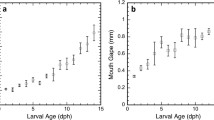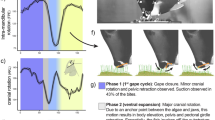Synopsis
High-speed cinematography and video using modified Schlieren optics and laser illumination helped elicit details of prey capture mechanisms used by Chromis viridis while feeding on calanoid copepods and Artemia. Chromis viridis is capable of a ram-jaw, low-suction feeding, as well as a typical suction feeding behavior described for other species of planktivores. By adjusting the degree of jaw protrusion and amount of suction used during a feeding strike, this fish can modulate its feeding strikes according to the prey type being encountered. The ram-jaw feeding mode enables C. viridis to capture highly evasive calanoid copepods within 6 to 10 msec. The use of specialized feeding behavior for evasive prey and the ability to vary feeding behavior are adaptations for feeding on evasive prey.
Similar content being viewed by others
References cited
Andrews, J.C. & P. Gentien. 1982. Upwelling as a source of nutrients for the Great Barrier Reef ecosystems: a solution to Darwin's question? Mar. Ecol. Prog. Ser. 8: 257–269.
Collette, B.B. & F.H. Talbot. 1972. Activity patterns of coral reef fishes with emphasis on nocturnal-diurnal changeover. pp. 98–124. In: B.B. Collette & S.A. Earle (ed.) Results of the Tektite Program: Ecology of Coral Reef Fishes, Los Angeles Co. Mus. Sci. Bull. 14.
Confer, J.L. & P.I. Blades. 1975. Omnivorous zooplankton and planktivorous fish. Limnol. Oceanogr. 20: 571–579.
Davis, W.P. & R.S. Birdsong. 1973. Coral reef fishes which forage in the water column. Helgoländer wiss. Meeresunters. 24: 292–306.
Drenner, R.F., J.R. Strickler & W.J. O'Brien. 1978. Capture probability: the role of zooplankter escape in the selective feeding of planktivorous fish. J. Fish. Res. Board Can. 35: 1370–1373.
Emery, A.R. 1973. Comparative ecology and functional osteology of 14 species of damselfish (Pisces: Pomacentridae) at Alligator Reef, Florida Keys. Bull mar. Sci. 23: 649–770.
Grobecker, D.B. & T.W. Pietsch. 1979. High-speed cinematographic evidence for ultrafast feeding in Antennariid anglerfishes. Science 205: 1161–1162.
Hamner, W.M., M.S. Jones, J.H. Carleton, I.R. Hauri & D.McB. Williams. 1988. Zooplankton, planktivorous fish, and water currents on a windward reef face: Great Barrier Reef, Australia. Bull. mar. Sci. 42: 459–479.
Hiatt, R.W. & D.W. Strasburg. 1960. Ecological relationships of the fish fauna on coral reefs of the Marshall Islands. Ecol. Monogr. 30: 65–127.
Hobson, E.S. 1974. Feeding relationships of the teleostean fishes on coral reefs in Kona, Hawaii. U.S. Fish. Bull. 72: 915–1031.
Hobson, E.S. & J.R. Chess. 1976. Trophic interactions among fishes and zooplankters near shore at Santa Catalina Island, California. U.S. Fish. Bull. 74: 567#x2013;598.
Janssen, J. 1976. Selectivity of an artificial filter feeder and suction feeders on calanoid copepods. Amer. Midl. Nat. 95: 491#x2013;493.
Janssen, J. 1978. Feeding behavior repertoire of the alewife, Alosa pseudoharengus, and the ciscoes Coregonus hovi and C. artedii. J. Fish. Res. Board Can. 35: 249#x2013;253.
Kerfoot, W.C., D.L. Kellogg, Jr. & J.R. Strickler. 1980. Visual observations of live zooplankters: evasion, escape, and chemical defenses. pp. 10#x2013;27. In: W.C. Kerfoot (ed.) Evolution and Ecology of Zooplankton Communities, University of New England Press, Hanover.
Kettle, D. & W.J. O'Brien. 1978. Vulnerability of arctic zooplankton species to predation by small lake trout (Salvelinus namaycush). J. Fish. Res. Board Can. 35: 1495–1500.
Lauder, G.V. 1980, The suction feeding mechanism in sunfishes (Lepomis): an experimental analysis. J. exp. Biol. 88: 49–72.
Lauder, G.V. 1986. Aquatic prey capture in fishes: experimental and theoretical approaches. J. exp. Biol. 125: 411–416.
Liem, K.F. 1979. Modulatory multiplicity in the feeding mechanism in cichlid fishes, as exemplified by the invertebrate pickers of Lake Tanganyika. J. Linn. Soc. (Zool) 189: 93–125.
Liem, K.F. 1980. Adaptive significance of intra- and interspecific differences in the feeding repertoires of cichlid fishes. Amer. Zool. 20: 295–314.
McComas, S.R. & R.W. Drenner. 1982. Species replacement in a reservoir fish community: silverside feeding mechanics and competition. Can. J. Fish. aquat. Sci. 39: 815–821.
Motta, P.J. 1982. Functional morphology of the head of the inertial suction feeding butterflyfish, Chaetodon miliaris (Perciformes, Chaetodontidae). J. Morph. 174: 283–312.
Motta, P.J. 1984. Mechanics and functions of jaw protrusion in teleost fishes: a review. Copeia 1984: 1–18.
Motta P.J. 1988. Functional morphology of the feeding apparatus of ten species of Pacific butterflyfishes (Perciformes, Chaetodontidae): an ecomorphological approach. Env. Biol. Fish. 22: 39–67.
O'Brien, W.J. 1987. Planktivory by freshwater fish: thrust and parry in the pelagia. pp. 1–16 In: W.C. Kerfoot & A. Sih (ed.) Predation, Direct and Indirect Impacts on Aquatic Communities University Press of New England, Hanover.
Osse, J.W.M. 1985. Jaw protrusion, an optimization of the feeding apparatus of teleosts? Acta Bioth. 34: 219–232.
Ralston, S. 1981. Aspects of the reproductive biology and feeding ecology of Chaetodon miliaris, a Hawaiian endemic butterflyfish. Env. Biol. Fish. 6: 167–176.
Randall, J.E., M.-L. Bauchot & M. Desoutter. 1985. Chromis viridis (Cuvier, 1830) the correct name for the Indo-Pacific damselfish previously known as C. caerulea (Cuvier, 1830) (Pisces, Pomacentridae). Cybium 9: 411–413.
Strickler, J.R. 1975. Swimming of planktonic Cyclops species (Copepoda, Crustacea): pattern, movements and their control. pp. 599–613. In: T.Y. -T. Wu, C.J. Brokaw & C. Brennan (ed.) Swimming and Flying in Nature, Volume 2, Plenum Press, New York.
Strickler, J.R. 1985. Feeding currents in calanoid copepods: two new hypotheses. Symp. Soc. exp. Biol. 39: 459–485.
Strickler, J.R. & A.K. Bal. 1973. Setae of the first antennae of the copepod Cyclops scutifer (Sars): their structure and importance. Proc. Natn. Acad. Sci. U.S.A. 70: 2656–2659.
Swerdloff, S.N. 1970. Behavioral observations on Eniwetok damselfishes (Pomacentridae: Chromis) with special reference to the spawning of Chromis caeruleus. Copeia 1970: 371–374.
Vinyard, G.L. 1980. Differential prey vulnerability and predator selectivity: effects of evasive prey on blue gill (Lepomis macrochirus) and pumpkinseed (L. gibbosus) predation. Can. J. Fish. aquat. Sci. 37: 2294–2299.
Vinyard, G.L. 1982. Variable kinematics of Sacramento perch (Archoplites interruptus) capturing evasive and nonevasive prey. Can. J. Fish. aquat. Sci. 39: 208–211.
Williams, D.McB. & A.I. Hatcher. 1983. Structure of fish communities on outer slopes of inshore, mid-shelf and outer shelf reefs of the Great Barrier Reef. Mar. Ecol. Prog. Ser. 10: 239–250.
Wolanski, E. & W.M. Hamner. 1988. Topographically controlled fronts in the ocean and their biological influence. Science 241: 177–181.
Wright, D.I. & W.J. O'Brien. 1984. The development and field test of a tactical model of the planktivorous feeding of white crappie (Poxomis annularis). Ecol. Monogr. 54: 65–98.
Author information
Authors and Affiliations
Rights and permissions
About this article
Cite this article
Coughlin, D.J., Strickler, J.R. Zooplankton capture by a coral reef fish: an adaptive response to evasive prey. Environ Biol Fish 29, 35–42 (1990). https://doi.org/10.1007/BF00000566
Received:
Accepted:
Issue Date:
DOI: https://doi.org/10.1007/BF00000566




